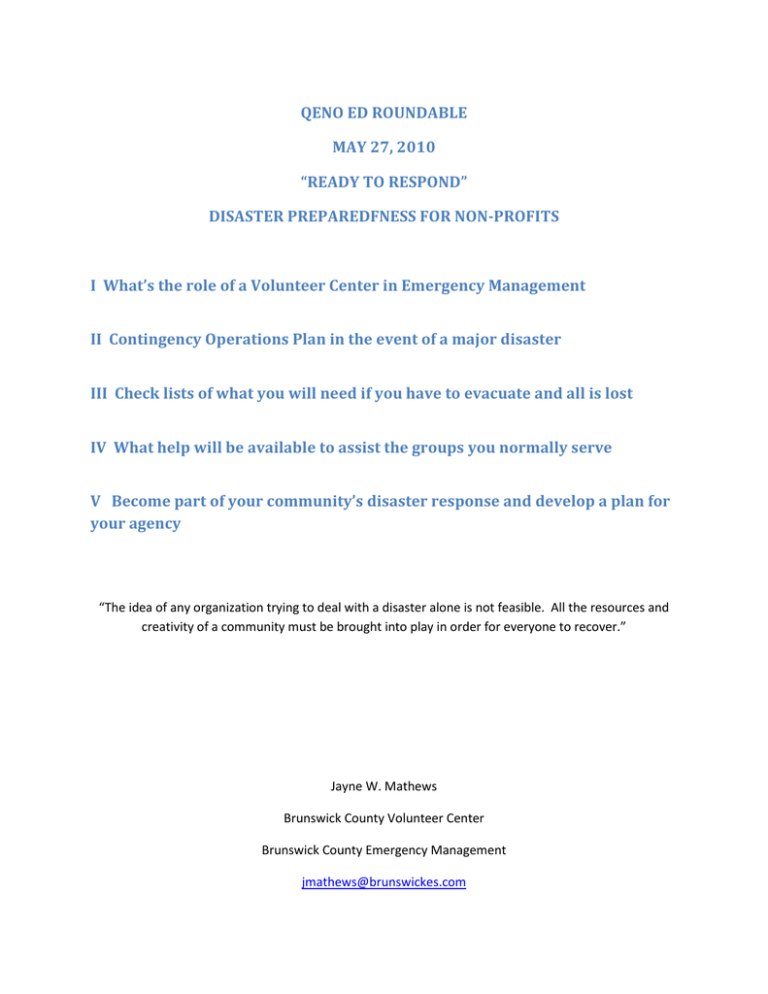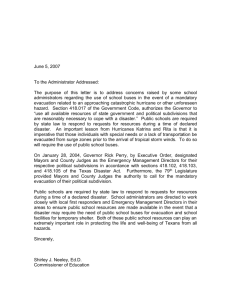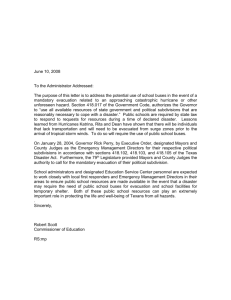QENO ED ROUNDABLE MAY 27, 2010 “READY TO RESPOND” DISASTER PREPAREDFNESS FOR NON-PROFITS
advertisement

QENO ED ROUNDABLE MAY 27, 2010 “READY TO RESPOND” DISASTER PREPAREDFNESS FOR NON-PROFITS I What’s the role of a Volunteer Center in Emergency Management II Contingency Operations Plan in the event of a major disaster III Check lists of what you will need if you have to evacuate and all is lost IV What help will be available to assist the groups you normally serve V Become part of your community’s disaster response and develop a plan for your agency “The idea of any organization trying to deal with a disaster alone is not feasible. All the resources and creativity of a community must be brought into play in order for everyone to recover.” Jayne W. Mathews Brunswick County Volunteer Center Brunswick County Emergency Management jmathews@brunswickes.com Developing a Disaster Plan for your Organization Before developing a disaster plan to meet the needs of your organization and your constituents, ask yourself these questions; 1. 2. 3. 4. 5. 6. 7. 8. 9. 10. 11. Who will activate the plan? How will others involved be notified? Have those involved already prepared a plan for themselves and their family? Do you have on hand survival equipment and emergency supplies? What procedures are in place for evacuation? How will records and equipment be protected? What happens if you lose power/phones? What if your facility is inaccessible? Are there procedures in place for identifying community needs? What can you do to best serve your constituents during a disaster? What is the purpose of your plan? What do you want to accomplish? Advance preparation, a well-drawn plan and a command team with community support will go a long way toward making your response effective. There are several stages of response to a major disaster; (a). Emergency relief (b) Short tern recovery (c) Long term recovery (d) Long term assistance Decide if you want to address all these stages or just one or two. Assess your capacity to aid others and the degree of readiness you want to prepare for. Also different disasters will demand a different response. Leadership is critical. Select a coordinator and an assistant coordinator whose primary role is planning. When disaster strikes, many others will be needed to activate your plan. Make sure you have enough members of your group (volunteers) to properly carry out you plan. Basic Steps for Disaster Plan 1. Develop a Disaster Response Activation Checklist Include a telephone call list and distribute to all involved. Have a back-up plan in the event of a phone outage. Decide who is in charge of activating the plan. Also decide on back-up communications such as two way radios. 2. Make sure each member of team has their own plan. Everyone must first take care of themselves and their own family first. Every member of the team should have a portable disaster kit which can be kept in office or cars. 3. What will you need at your facility. Make a list of supplies and equipment that will be needed at your disaster facility. Make arrangements for members of the team to be able to stay there for an extended period. Have a “Go-Kit” ready to set up at another location, if necessary. Have a duplicate set of accounting records and essential computer programs and data stored off site. 4. Develop an Evacuation Plan Should you need to evacuate in the event of a loss of your facility, establish a place where team can meet after an evacuation. Develop a contingency plan to set up at this location. Also develop a call list for keeping in touch during an evacuation. During a severe disaster you may have to leave and return to a location where you can temporarily set-up operations. During a severe disaster, the health and safety of those on your premises is the first concern. 5. Public Information Plan Decide how you would keep your constituents informed after a disaster as to where you are and what you can offer in emergency assistance. Appoint someone in the group to be in charge of this messaging. Clearly define what you can and cannot provide. 6. Training Training may include personal preparedness, donations management, sheltering and evacuation plans. There are many sources for training materials. Consider working with Emergency Management as well as other national organizations such as the Red Cross. Also consider in your disaster plan mutual aid agreements with affiliates in other areas. 7. Donated Goods. Ask for and accept what you can handle and confirm that there is a need for what you ask for. Think about how the goods will be stored and transported. Decide who is in charge and identify what is needed and what is not needed. Don’t hesitate to say no if you don’t have use for something. 8. Define where your assistance can be most effective. Don’t try to do too much at once. Emergency Relief: food, clothing, shelter, medical assistance and immediate needs. Short Term Recovery: Assisting survivors in finding family members, helping them to find temporary housing or connecting them with assistance agencies ( state, federal and local). Long Term Recovery: requires volunteers with different skills. Peak interest in the disaster may have dissipated and the rush to help may be over. This is the area where there may be the greatest need. When the crisis is over, recovery and rebuilding may require a major commitment.






